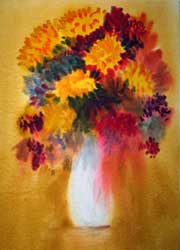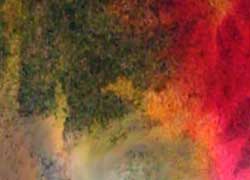

Wet in wet is the queen of watercolor techniques - Here is an example a flower arrangement.
MATERIALS LIST
Hover Or Click
A Color For Information
Burnt Sienna
A sedimentary color; sediments quickly offering a mottled or shimmery look to the final (wash)
+ close +Viridian
A sedimentary color; sediments quickly offering a mottled or shimmery look to the final (wash)
+ close +Pthalocyanine Blue
A "warm" (greenish) blue.
A non sedimentary color settles out smoothly yielding a uniform finish (wash)
+ close +Pyrrol Red
A "warm" (orangish) red.
A non sedimentary color settles out smoothly yielding a uniform finish (wash)
+ close +Arylide Yellow FGL
A "warm" (orangish) yellow.
A non sedimentary color settles out smoothly yielding a uniform finish (wash)
There is not an industry standard name for this color. I am offering DaVincis Brand name.
+ close +Yellow Ocher
A sedimentary color.
sediments quickly offering a mottled or shimmery look to the final (wash)
+ close +Cerulean Blue
A sedimentary color.
Sediments quickly offering a mottled or shimmery look to the final (wash)
+ close +Ultramarine Blue
A cool (purplish) blue.
A non sedimentary color settles out smoothly, theoretically yielding a uniform final (wash).
Actually Ultramarine Blue "flocculates" (gathers in clumps) so we only get a fairly smooth (wash)
Sadly, it's the only purplish blue thats light-fast and available to artists.
+ close +Alizarin Crimson
( Quinacridone )
A cool (purplish) red.
A non sedimentary color settles out smoothly yielding a uniform finish (wash)
n fact, Alizarine Crimson (a very early man made pigment) lost favor when it was found non light-fast.
Today we replace it it with a better version of the same color called Quinacdridone Red.
Nevertheless, manufacturers still call it Alizerine Crimson.
+ close +A cool (greenish) yellow
A non sedimentary color settles out smoothly yielding a uniform finish (wash)
There is not an industry standard name for this color. I am offering the DaVincis Brand name.
+ close + Wet in wet is the queen of watercolor painting. The reason is that when we paint wet paint into thoroughly wet watercolor paper, the particles of pigment settle out into the little hills and valleys of the paper. This "sedimentation" is what makes watercolor washes so gorgeous. The paint diffuses into the surrounding areas depending on how wet each area is. This gives us the ability to paint soft, slightly out of focus pictures. The technique of wet in wet produces lovely, tranquil works; but they remain visually exciting both from a distance as well as very close up.
Wet in wet is the queen of watercolor painting. The reason is that when we paint wet paint into thoroughly wet watercolor paper, the particles of pigment settle out into the little hills and valleys of the paper. This "sedimentation" is what makes watercolor washes so gorgeous. The paint diffuses into the surrounding areas depending on how wet each area is. This gives us the ability to paint soft, slightly out of focus pictures. The technique of wet in wet produces lovely, tranquil works; but they remain visually exciting both from a distance as well as very close up.
The trick to getting this effect is in the paint selection. We select paints for their sedimentary properties. By this we mean the properties of the pigment particles. Some are very light. The light ones do not settle easily and so "migrate" from where they are put and give us the soft, diffuse look. The heavy ones tend to clump, or settle, or both. This "aggregation" of the heavy particles sink into the papers valleys. Every color acts a little differently so the effect is continually changing thereabout the painting. You cannot ask for a lovelier technique.
 Wet in wet of this type is not for the beginner, even though many people come to watercolor for just this reason. You need time to get used to your paints and how they feel. You might want to start with my palette, (paint selection), its well thought out.
Wet in wet of this type is not for the beginner, even though many people come to watercolor for just this reason. You need time to get used to your paints and how they feel. You might want to start with my palette, (paint selection), its well thought out.
You might also want to see three of my beginner materials lessons, paint, paper, stretching paper, to better understand what I am doing in this lesson and why.
The colors in this demonstration are the yellow - purple complementary color scheme, with yellow predominating. There are green notes added in a few places. The composition is entirely curvilinear. The negative space is subordinated (smaller) to the positive (larger).
Watercolor Painting Tutorials Watercolor Materials

A Wet In Wet Watercolor Painting Lesson.

How To Create Depth In A Painting.

Painting A Basket - A Lesson Lifting Watercolor Paint - Part 1.

Filling The Basket - A Lesson In Painting Objects Part 2.

Watercolor Lesson - Monoprinting - Texturing With Plastic Wrap.

Landscape Shadows. A Demonstration

Color For Beginners - How to mix all the colors.

Color schemes - How to plan the colors of a painting.

How to paint emotions using warm and co

Abstract Art - A discussion.